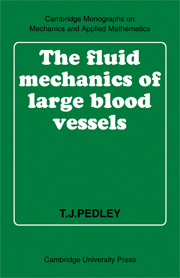Book contents
- Frontmatter
- Contents
- Preface
- 1 Physiological introduction
- 2 Propagation of the pressure pulse
- 3 Flow patterns and wall shear stress in arteries
- 4 Flow patterns and wall shear stress in arteries
- 5 Flow patterns and wall shear stress in arteries
- 6 Flow in collapsible tubes
- Appendix: Analysis of a hot-film anemometer
- References
- Index
- Frontmatter
- Contents
- Preface
- 1 Physiological introduction
- 2 Propagation of the pressure pulse
- 3 Flow patterns and wall shear stress in arteries
- 4 Flow patterns and wall shear stress in arteries
- 5 Flow patterns and wall shear stress in arteries
- 6 Flow in collapsible tubes
- Appendix: Analysis of a hot-film anemometer
- References
- Index
Summary
Some knowledge of fluid mechanics is required before the circulation of the blood can be understood. Indeed, the single fact that above all others convinced William Harvey (1578–1657) that the blood does circulate was the presence in the veins of valves, whose function is a passive, fluid mechanical process. He saw that these could be effective only if the blood in the veins flowed towards the heart, not away from it as proposed by Galen (129–199) and believed by the European medical establishment until Harvey's time. Harvey was also the first to make a quantitative estimate of the output of blood from the human heart and this, although a gross underestimate (36 oz, i.e. about 1 litre, per minute instead of about 5 litres per minute) was largely responsible for convincing the sceptics that the arterial blood could not be continuously created in the liver and, hence, that it must circulate.
The earliest quantitative measurements of mechanical phenomena in the circulation were made by Stephen Hales (1677–1761) who measured arterial and venous blood pressure, the volume of individual chambers of the heart and the rate of outflow of blood from severed veins and arteries, thereby demonstrating that most of the resistance to blood flow arises in the microcirculation. He also realised that the elasticity of the arteries was responsible for blood flow in veins being more or less steady, not pulsatile as in arteries.
- Type
- Chapter
- Information
- The Fluid Mechanics of Large Blood Vessels , pp. xi - xviPublisher: Cambridge University PressPrint publication year: 1980



